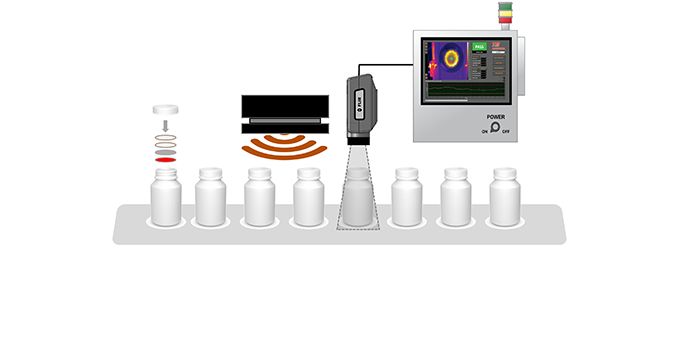The main difference between an induction seal and a heat seal is the way in which the seal is created. Induction sealing uses electromagnetic induction to generate heat and create a tamper-evident seal, while heat sealing uses heat to bond two materials together.
 Induction Seal vs Heat Seal: What's the difference?
Induction Seal vs Heat Seal: What's the difference?

Article from | MoviTHERM
The main difference between an induction seal and a heat seal is the way in which the seal is created. Induction sealing uses electromagnetic induction to generate heat and create a tamper-evident seal, while heat sealing uses heat to bond two materials together. In this article, we break things down to compare the benefits and challenges of an induction seal vs a heat seal.
Induction Seals
An induction seal is a type of closure that is applied to the top of a container. It is made of a layer of material that is bonded to the top of the container and creates a tamper-evident seal when it is heated by induction.
Induction sealing is a non-contact sealing process that uses electromagnetic induction to generate heat in a conductive material. This heat is used to seal the top of a container, such as a bottle or jar, in order to preserve the freshness and quality of the product inside.
Benefits of Using an Induction Seal Machine
There are several benefits to using an induction seal machine:
- Tamper-evident: Induction sealing creates a tamper-evident seal that is difficult to remove or break without leaving evidence of tampering. This helps to ensure the integrity of the product inside the container and can provide peace of mind for consumers.
- Preservation: Induction sealing helps to preserve the freshness and quality of the product inside the container. The seal helps to prevent contamination and can extend the shelf life of the product.
- Customization: Induction sealing equipment can be customized to work with a wide range of container sizes and shapes, making it suitable for a variety of applications.
- Efficiency: Induction sealing is a fast and efficient sealing process that can be easily integrated into a production line. It can seal containers at a high speed, which can help to increase productivity.
- Versatility: Induction sealing can be used with a variety of container materials, including plastic, glass, and metal. It can also be used with a wide range of products, including food, beverages, pharmaceuticals, and personal care products.
Challenges in Induction Seals
There are a few challenges that can arise when using induction sealing:
- Conductive material: Induction sealing requires the use of a conductive material, such as aluminum foil, in order to create the seal. If the material is not properly applied or is not of sufficient quality, it may not create a proper seal.
- Container size and shape: Induction sealing equipment is typically designed to work with a specific range of container sizes and shapes. If the container is outside of this range, it may not be compatible with the sealing equipment.
- Container material: The material of the container can also affect the effectiveness of the induction seal. Some materials, such as glass or certain types of plastic, may not be suitable for induction sealing.
Heat Seals
A heat seal, on the other hand, is a type of sealing process that uses heat to bond two materials together. Heat sealing is often used in packaging to seal bags or pouches, or to seal the edges of plastic sheets or films. This type of sealing process can be done using a variety of methods, including hot bar sealing, impulse sealing, and continuous sealing.
Benefits of Using a Heat Seal Machine
There are several benefits to using a heat seal machine:
- Speed: Heat sealing is a fast and efficient sealing process that can be easily integrated into a production line. It can seal bags or pouches at a high speed, which can help to increase productivity.
- Customization: Heat sealing equipment can be customized to work with a wide range of materials and seal configurations, making it suitable for a variety of applications.
- Versatility: Heat sealing can be used with a variety of materials, including plastic films and bags, paper products, and foil-lined materials. It can also be used to seal a wide range of products, including food, beverages, pharmaceuticals, and personal care products.
- Reliability: Heat sealing is generally considered a reliable sealing method that can create strong, consistent seals that are resistant to tampering and can withstand exposure to a variety of environmental conditions.
- Ease of use: Heat sealing equipment is typically easy to operate and maintain, making it suitable for businesses of all sizes. Overall, the benefits of using a heat seal machine depend on the specific application and the materials being sealed.
Challenges in Heat Seals
There are a few challenges that can arise when using heat sealing:
- Material compatibility: Heat sealing requires the use of materials that are compatible with the sealing process. If the materials being sealed are not compatible, the seal may be weak or may not hold up over time.
- Temperature: Heat sealing requires a specific temperature in order to create a strong, reliable seal. If the temperature is too low, the seal may not be strong enough. If the temperature is too high, the materials being sealed may be damaged or may become too weak to hold up over time.
- Speed: Some heat sealing processes, such as continuous sealing, require a high level of speed and precision in order to be effective. If the sealing process is not fast enough, it may result in weak or inconsistent seals.
- Pressure: Heat sealing often requires the application of pressure in order to create a strong seal. If the pressure is not sufficient, the seal may be weak or may fail.
Add Quality Assurance to Your Sealing Method
Thermal seal inspection can be used for quality assurance in heat seals and induction seals by identifying any defects or inconsistencies in the sealing process. This can help to ensure that the seals are strong, consistent, and reliable, which is important for preserving the quality and integrity of the product inside the container.
In the case of heat seals, thermal seal inspection can be used to identify any defects or inconsistencies in the sealing process that may result in weak or broken seals. This can be particularly important for products that are sensitive to contamination or require a long shelf life.
In the case of induction seals, thermal seal inspection can be used to ensure that the seals are properly applied and are of sufficient quality to preserve the product inside the container. This can help to ensure that the product remains fresh and of high quality until it is opened by the consumer.
Overall, thermal seal inspection is an important quality assurance tool for both heat seals and induction seals, as it helps to ensure that the seals are strong and reliable, and that the product inside the container is protected from contamination and other environmental factors.
The content & opinions in this article are the author’s and do not necessarily represent the views of ManufacturingTomorrow
Featured Product

